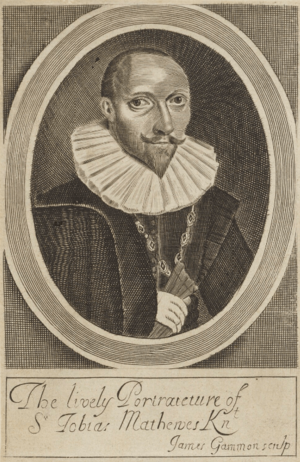Tobie Matthew facts for kids
Quick facts for kids
Sir Tobie Matthew
|
|
|---|---|

in 1660
|
|
| Born |
Tobias Matthew
3 October 1577 |
| Died | 13 October 1655 (aged 78) |
| Nationality | English |
| Occupation | Member of Parliament (1599–1604) Royal Advisor to Elizabeth I (1599–1603) to James I (1603–1604 and 1622–1625) to Charles I & Queen Henrietta Maria (1625–1640) |
| Years active | 1599–1640 |
| Known for | espionage for James I |
| Parent(s) | Tobias Matthew Frances (born Barlow) |
Sir Tobie Matthew (born 3 October 1577, died 13 October 1655) was an important figure in English history. He was a Member of Parliament (a person elected to represent people in government) and worked closely with the royal family. Tobie Matthew converted to Roman Catholicism and later became a priest.
He was sent on a special mission to Spain to help arrange a marriage between Prince Charles (who later became King Charles I) and a Spanish princess named Maria Anna. For his efforts, he was made a knight. Sir Tobie Matthew left England in 1641 after being wrongly accused of leading Catholics. He spent his final years in Ghent.
Contents
Sir Tobie Matthew's Life
Early Years and Family
Tobie Matthew was born in Salisbury, England. His father, also named Tobias Matthew, was a very important church leader. He started as the Dean of Christ Church, Oxford, then became the Bishop of Durham, and finally the Archbishop of York. His mother was Frances Barlow.
Tobie went to Christ Church, Oxford, and later studied law at Gray's Inn in London. There, he became close friends with Francis Bacon, a famous writer and philosopher. Tobie faced some financial challenges when he was young.
Becoming a Member of Parliament
In 1601, Tobie Matthew was elected as a Member of Parliament for Newport, a town in Cornwall. During this time, he often visited the court of Queen Elizabeth I.
After King James I came to the throne, Tobie was elected to Parliament again in 1604, this time representing St Alban's. He also joined King James's court, where he received support from the King.
Travels and Changing Faith
In 1604, Tobie Matthew left England to travel. He went through France and then to Florence, Italy. Even though he had promised his father he wouldn't go to Italy, he did.
In Florence, he met many Roman Catholics and decided to convert to Catholicism in 1606. At that time, Catholics faced difficulties in England. Despite this, Tobie was determined to return. When he arrived back in England, he was put in Fleet Prison for six months. People tried to make him change his mind about his new faith, but he refused.
In 1608, he was allowed to leave England again and traveled in Flanders and Spain. In 1614, he studied to become a priest in Rome and was ordained (made a priest) by Cardinal Bellarmine.
Working for the King
King James allowed Tobie Matthew to return to England in 1617. He stayed with his friend Francis Bacon and even wrote an introduction for the Italian version of Bacon's famous Essays.
From 1619 to 1622, Tobie was sent away from England again because he would not take a special oath of loyalty. However, when he returned, King James welcomed him warmly.
Tobie then worked as an agent at court to help arrange a marriage between Prince Charles (who became King Charles I) and Maria Anna of Spain, a Spanish princess. This proposed marriage was known as the "Spanish Match." King James sent Tobie to Madrid to help with this plan. When he returned, the King made him a knight in 1623.
Sir Tobie Matthew was also a close friend of the new queen, Queen Henrietta Maria. He worked hard to support the Roman Catholic faith at court. He was known for his charming and playful personality. For example, he once offered to make the queen a new Spanish drink called chocolate, but he accidentally drank it all himself!
He was once wrongly accused of helping a noblewoman, Anne Blount, convert to Catholicism. After this, he stayed away from the court for a while.
Later Years and Exile
Sir Tobie Matthew's father passed away in 1628, leaving his wealth to his wife, Frances. When Frances died in 1629, she left Tobie a single diamond ring, with most of her money going to her grandchildren, nieces, and nephews.
After the English Civil War began in 1640, Tobie Matthew was again wrongly accused of things. By this time, he was in his sixties. He left England for the last time in 1641.
He found safety with the English Jesuits (a group of Catholic priests) at their house in Ghent. There, he became a spiritual advisor to the Abbess (the head nun) Elizabeth Knatchbull. He admired her greatly and wrote her life story, which was published much later in 1931.
Sir Tobie Matthew died at the English College in Ghent and was buried there. It is still debated whether he himself ever officially became a Jesuit.

